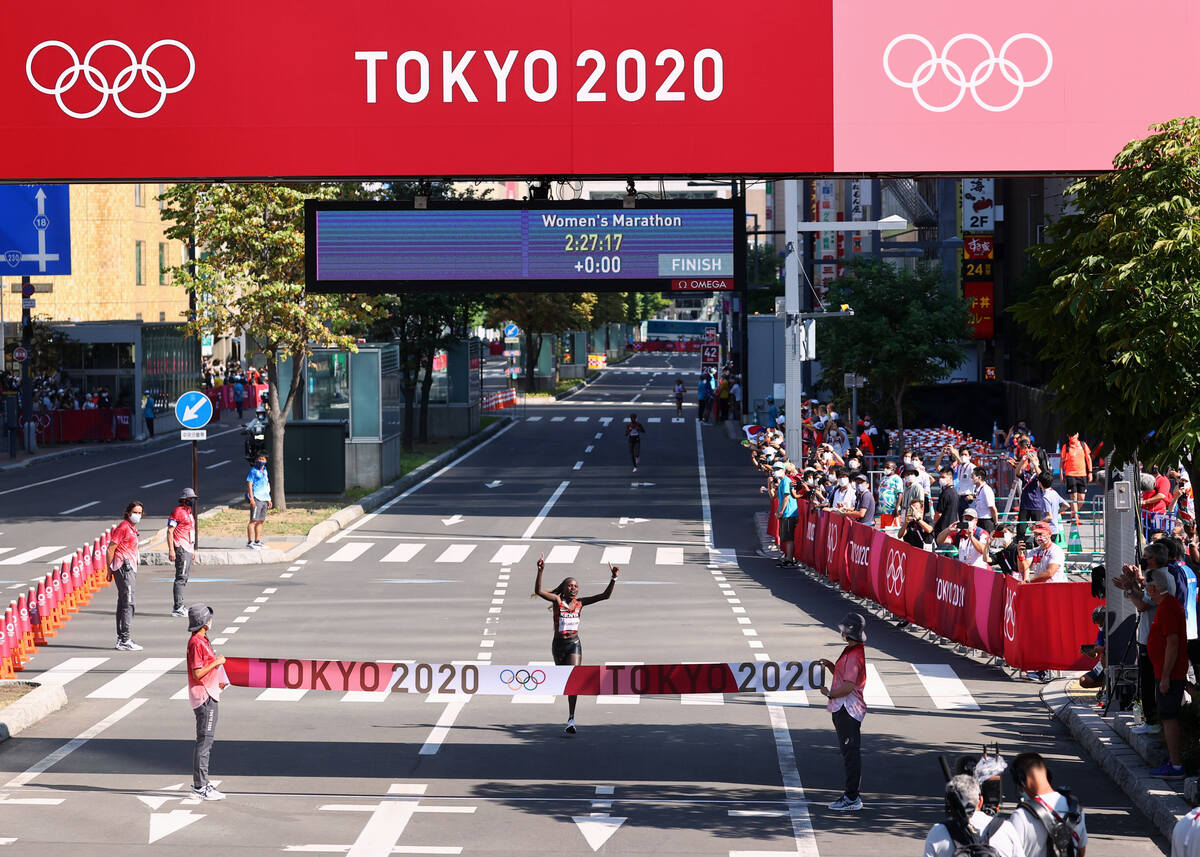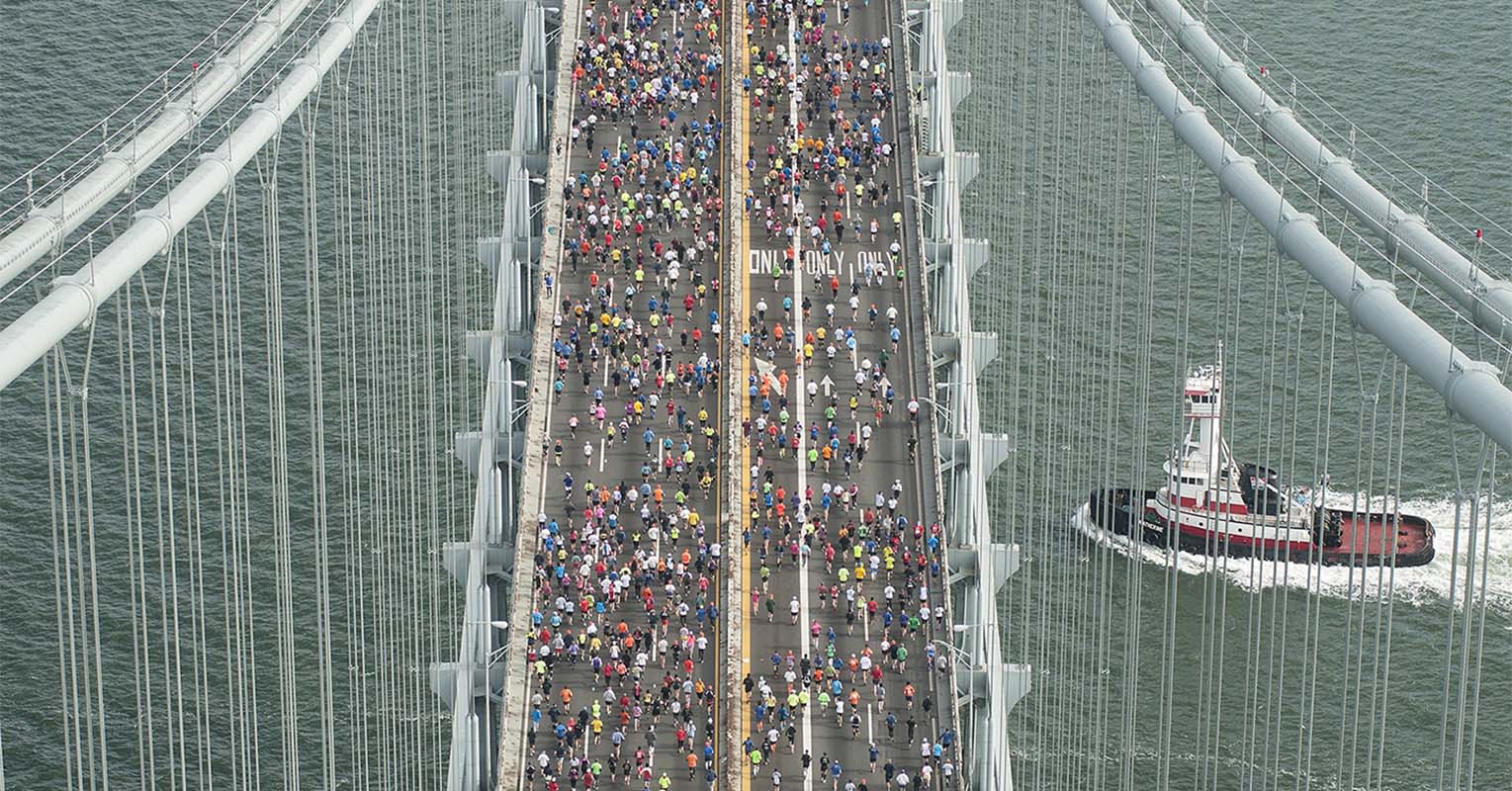

Featured
Why Is A Marathon 26.2 Miles
Modified: January 22, 2024
Learn why a marathon is 26.2 miles and uncover the history and significance behind this iconic distance. Discover the reasons that make it a featured event in the running world.
Introduction
Marathons have become synonymous with endurance, determination, and the ultimate test of human strength. Runners around the world train rigorously to conquer the grueling 26.2-mile challenge. But have you ever wondered why marathons are specifically 26.2 miles long? What is the origin behind this iconic distance? In this article, we will delve into the fascinating history and evolution of the marathon, uncovering the reasons that led to the establishment of the 26.2-mile standard.
The marathon can trace its roots back to ancient Greece, where legend has it that a messenger named Pheidippides ran from the city of Marathon to Athens to deliver news of the Greek victory over the Persians. As the story goes, Pheidippides collapsed and died immediately after completing his arduous journey. This heroic act of endurance gave birth to the marathon race.
Initially, the marathon distance was not standardized, and races varied in length. The first organized marathon event took place during the inaugural modern Olympics in Athens in 1896. The course spanned approximately 24.85 miles, starting from the Marathon Bridge and ending at the Olympic Stadium. While this distance may seem odd, it was chosen to represent the distance from the city of Marathon to Athens, as a tribute to the historical legend.
Over time, the need for a standardized marathon distance became evident, as different races featured varying course lengths. The turning point came during the London Olympics of 1908, when the course had to be extended to allow the race to start at Windsor Castle so that the royal family could witness the start from their residence. As a result, the marathon distance was adjusted to 26.2 miles, with the start line moved to Windsor while the finish remained at the Olympic Stadium in White City.
Since then, the 26.2-mile marathon distance has become the gold standard in the running world. But why was this particular distance chosen? What factors influenced the decision and set the precedent for marathons worldwide? In the following sections, we will explore the significance of the 26.2-mile distance and the enduring impact it has had on the sport of marathon running.
Origins of the Marathon
The origins of the marathon can be traced back to ancient Greece, where the concept of a long-distance race was born. According to legend, the very first marathon was run by a Greek messenger named Pheidippides, who was tasked with delivering a message of victory from the battlefield of Marathon to the city of Athens.
During the Battle of Marathon in 490 BC, the Greeks achieved a decisive victory over the Persians. As the story goes, Pheidippides was chosen to run over 25 miles from Marathon to Athens to deliver the news of the victory. Despite the exhaustion from the battle, Pheidippides ran nonstop, pushing himself to the limits of his physical endurance.
When he finally arrived in Athens, Pheidippides announced the victory before collapsing and dying from exhaustion. His incredible feat of endurance became legendary, and the marathon race was created in his honor.
The marathon’s ties to ancient Greece are evident in its name. The word “marathon” originates from the Greek word “marathos,” which refers to a fennel-like plant that grows abundantly along the route of Pheidippides’ run. In fact, the name “marathon” itself symbolizes the historical significance and cultural roots of this iconic race.
Athens, the birthplace of the marathon, hosted the first modern Olympic Games in 1896. The organizers of the Games wanted to pay homage to the ancient origins of the marathon and incorporate it as a key event in the Olympic program. Thus, the marathon race was reintroduced, spanning a distance that closely resembled the original route from Marathon to Athens.
While the exact distance of Pheidippides’ run is debated, it is believed to have been around 25 miles. The marathon distance in the modern Olympic Games, however, was initially set at approximately 24.85 miles (or 40 kilometers). This distance was chosen to reflect the historical legend and serve as a symbolic connection to the original marathon run.
As the popularity of the marathon grew, so did the desire for a standardized distance. The need for consistency was essential to ensure fair competition among runners in different races. This led to the eventual establishment of the now universally recognized marathon distance of 26.2 miles.
The origins of the marathon, rooted in the legendary run of Pheidippides, provide a rich historical context for understanding the significance and enduring legacy of this challenging race. In the following sections, we will explore how the marathon distance evolved and the reasons behind the choice of 26.2 miles.
The Distance Conundrum
When the marathon distance was first introduced in the modern Olympic Games, it was set at approximately 24.85 miles (40 kilometers) to align with the historical route from Marathon to Athens. However, as marathons started to gain popularity beyond the Olympics, race organizers faced a conundrum – what should be the standard distance for future races?
There was a growing need to establish a consistent and universally accepted marathon distance to ensure fairness and comparability in races around the world. However, determining the exact distance proved to be a challenge, as there were several factors to consider.
One of the main considerations was the availability of suitable road courses. Organizers needed to find routes that showcased the beauty of the host city while also providing a challenging yet manageable course for runners. This often meant that slight adjustments to the distance were made based on the available roads and terrain.
Another factor was the desire to create a distance that was challenging but still achievable for the average runner. Marathon distances shorter than 24.85 miles were considered, but it was feared that they would not adequately test the endurance of the participants. Conversely, longer distances would likely discourage many potential runners from even attempting the race.
Furthermore, the logistics and practicality of organizing a marathon had to be taken into account. Preparing a start and finish line, providing water stations, medical support, and crowd management all required careful planning. A distance that allowed for efficient organization and ensured the safety of participants and spectators was crucial.
The decision regarding the standardization of the marathon distance faced significant debates and discussions within the running community. Some proposed increasing the distance to promote a greater physical challenge, while others argued for a shorter distance to encourage wider participation.
Ultimately, it was the London Olympics of 1908 that played a pivotal role in resolving the distance conundrum. The marathon route had to be extended to allow the race to start from Windsor Castle so that the royal family could witness the start from their residence. This adjustment resulted in a distance of 26.2 miles, with the start line moved to Windsor and the finish line remaining at the Olympic Stadium in White City.
The choice of 26.2 miles not only satisfied the logistical requirements of the London Olympics but also struck a balance between being challenging enough to test the limits of the participants and being attainable for dedicated and trained runners. It became the benchmark distance against which all future marathons would be measured.
The resolution of the distance conundrum marked a significant milestone in the evolution of the marathon, providing a standardized distance that could be replicated globally. In the next section, we will explore the various factors that influenced the selection of 26.2 miles as the official distance of the marathon.
The London Olympics of 1908
The London Olympics of 1908 played a crucial role in solidifying the marathon distance we know today. Originally scheduled to take place in Rome, the Games were relocated to London due to the eruption of Mount Vesuvius in Italy. This change of location had a significant impact on the history and development of the marathon distance.
The marathon event at the London Olympics of 1908 holds a special place in Olympic history. It was a race filled with drama, controversy, and unexpected turns that shaped the future of the marathon. One of the most significant changes was the extension of the marathon route from the traditional 24.85 miles to the now famous 26.2 miles.
The decision to lengthen the race came about due to a unique set of circumstances. The course was adjusted to accommodate the honor of starting the race from Windsor Castle, allowing the British royal family to witness the event. The additional distance from the start line at Windsor to the finish line at the Olympic Stadium in White City resulted in the marathon distance being extended by 1.2 miles.
This modification presented a challenge for the race organizers and participants. With the course alteration, the marathon distance was officially set at 26.2 miles for the London Olympics of 1908.
The race itself was far from predictable. The event began at Windsor, with the starting line marked by a tape rather than the more traditional pistol shot. The original plan was for the runners to follow a lead vehicle, but it experienced a mechanical failure, causing confusion and misdirection among the participants.
Italian runner Dorando Pietri emerged as the front-runner, but he grew increasingly disoriented as he approached the finish line at the Olympic Stadium. Exhausted and delirious, he took the wrong turn and had to be helped back onto the track by officials.
Pietri displayed an incredible show of determination and perseverance as he staggered towards the finish line, only to collapse just short of reaching it. Despite being disqualified, his valiant effort captured the hearts of spectators and garnered widespread media attention.
The dramatic finish of Dorando Pietri brought attention to the grueling nature of the marathon and showcased its ability to push runners to their physical and mental limits. This heightened interest in the event further solidified the status of the marathon as the ultimate test of endurance and human resilience.
Following the London Olympics of 1908, the extended marathon distance of 26.2 miles became increasingly accepted and desired by organizers of other races. It was seen as the benchmark distance that represented the true challenge and spirit of the marathon.
The London Olympics of 1908 not only established the trend of the 26.2-mile marathon distance but also highlighted the drama and excitement that surround this iconic event. In the next section, we will explore the various factors that influenced the selection of this specific distance and its enduring significance.
The Standardization of the Marathon Distance
Following the London Olympics of 1908, the marathon distance of 26.2 miles began to gain traction and recognition as the standard distance for the race. The unique circumstances and the successful implementation of the extended distance in the London Games set a new precedent that would shape the future of marathon running.
The extended marathon distance created for the London Olympics of 1908 was not immediately adopted by all races. However, as the popularity of marathons increased, more and more organizers embraced the 26.2-mile distance. This trend was driven by the desire for uniformity and the need for a consistent benchmark to compare race times and achievements across different events.
By the early 1920s, the vast majority of marathon races around the world had settled on the distance of 26.2 miles. This standardization helped to foster greater participation and competition in the sport, as runners knew what distance to expect when signing up for a marathon.
The International Association of Athletics Federations (IAAF), the governing body for track and field sports, officially recognized the 26.2-mile distance as the official marathon distance in 1921. This recognition further solidified the status of the marathon distance and validated the choices made by race organizers worldwide.
While the 26.2-mile distance became the accepted standard, it is worth noting that a few exceptions persist. Some marathons, particularly those held in certain countries that utilize the metric system, adhere to a 42.195-kilometer distance. This slight discrepancy is due to the standardization of distance measurements in the International System of Units (SI).
One might wonder why the 26.2-mile distance has endured for over a century and continues to be recognized as the official marathon distance. There are several factors that have contributed to its significance:
- Historical Legacy: The association of the marathon distance to the legendary run of Pheidippides and its inclusion in the ancient Olympic Games gives it a strong historical and cultural significance.
- Human Achievement: The 26.2-mile distance represents an incredible feat of human endurance and perseverance, challenging runners to push beyond their limits.
- Comparability: The standardized distance allows for fair competition and the ability to compare race times and achievements across different races and continents.
- Global Recognition: The 26.2-mile marathon distance has become ingrained in popular culture and is instantly recognized by people around the world as the ultimate long-distance running challenge.
The standardization of the marathon distance has played a crucial role in the growth and development of marathon running. It has provided a clear and universally accepted goal for runners to strive for, inspiring countless individuals to take on the challenge and experience the thrill of crossing the finish line after 26.2 grueling miles.
In the next section, we will delve deeper into some of the factors that influenced the choice of 26.2 miles and explore why this particular distance has stood the test of time.
Factors Influencing the Choice of 26.2 miles
Several factors played a significant role in the selection of the 26.2-mile distance as the standard for marathon races. These factors took into account historical, practical, and logistical considerations, as well as the desire to create a challenging yet achievable distance for runners.
One of the primary factors influencing the choice of 26.2 miles is the historical significance attached to the marathon race. The distance pays homage to the legendary run of Pheidippides from Marathon to Athens, symbolizing the ancient origins of the marathon. This connection to history adds a level of tradition and prestige to the 26.2-mile distance.
Practicality and logistics were also crucial considerations. Organizers needed to create a distance that could be accurately measured and easily replicated across different courses. The 26.2-mile distance provided a manageable framework for designing marathon routes, incorporating landmarks, historical sites, or scenic views, while still offering a challenge to runners.
Creating a marathon distance that was challenging yet attainable for dedicated runners was a delicate balance. The 26.2-mile distance struck that balance, providing a test of endurance and stamina while ensuring that it was within reach for those committed to training and preparing for the race.
Additionally, the desire for comparability and record-keeping influenced the choice of 26.2 miles. Having a standardized distance allowed for fair competition among runners from different races and locations. It also facilitated the tracking and comparison of race times, records, and achievements, creating a global standard for marathon performances.
Another factor that contributed to the selection of 26.2 miles is the psychological and symbolic significance of the distance itself. The achievement of completing a full marathon after running 26.2 miles is seen as a monumental accomplishment, often regarded as a lifetime goal for many runners. The allure of conquering this specific distance has motivated countless individuals to take up the sport and push beyond their limits.
While other marathon distances were considered and even implemented in some races, the overwhelming acceptance and recognition of the 26.2-mile standard solidified its status as the official marathon distance. It became a part of the fabric of marathon running, synonymous with the challenge, triumph, and unity that the race represents.
Ultimately, the factors influencing the choice of 26.2 miles intertwined practicality, tradition, and the desire to create an enduring test of human endurance. This distance has stood the test of time, becoming a universal symbol of the marathon and inspiring runners around the world to push themselves to new heights.
In the final section, we will explore the significance and impact of the marathon distance and its place in the sporting world.
The Significance of the Marathon Distance
The marathon distance of 26.2 miles holds great significance in the world of running and beyond. It has become a symbol of human resilience, determination, and the pursuit of personal achievement. The impact of the marathon distance extends far beyond the confines of the race itself, reaching into various domains of society.
First and foremost, the marathon distance represents an incredible physical and mental challenge. Running 26.2 miles requires immense endurance, strength, and discipline. Training for and completing a marathon pushes individuals to their limits and often involves months of dedicated preparation. Crossing the finish line after conquering this distance is a tremendous accomplishment, instilling a sense of pride and self-belief.
The marathon distance is also a source of inspiration and motivation for runners and non-runners alike. It serves as a tangible goal, a personal benchmark against which progress can be measured. Many individuals set the completion of a marathon as a life goal or a bucket list achievement, using the distance as a catalyst for personal growth and transformation.
Furthermore, the marathon distance has a unifying power, bringing together people from diverse backgrounds and cultures. Marathons are events that attract participants from around the world, fostering a shared sense of camaraderie and solidarity. The common goal of completing the marathon distance creates a unique bond among runners, forming a global community that celebrates the pursuit of physical and mental well-being.
Beyond the realm of sports, the marathon distance has had cultural and societal impacts. It has served as a platform for charitable causes and fundraising efforts. Many marathons are associated with charitable organizations, providing an opportunity for runners to raise awareness and funds for important social causes, making a positive difference in their communities.
The marathon distance is also a source of inspiration for spectators and supporters. Watching runners push themselves to complete 26.2 miles can inspire others to challenge themselves, overcome obstacles, and strive for greatness in their own lives. The resilience and determination displayed by marathon runners can have a ripple effect, encouraging others to pursue their dreams and push their boundaries.
Finally, the endurance and perseverance required to complete a marathon can have profound impacts on an individual’s mindset and personal development. The training and preparation for a marathon instill traits such as discipline, goal-setting, resilience, and mental toughness. These qualities can extend beyond the race itself, influencing various aspects of life, including work, relationships, and personal growth.
The significance of the marathon distance extends far beyond the physical act of running. It represents the triumph of human spirit, the pursuit of personal excellence, and the power of community. Whether as a participant or a spectator, the marathon distance has the ability to inspire, unite, and leave a lasting impact on individuals and society as a whole.
Conclusion
The marathon distance of 26.2 miles holds a prominent place in the world of sports and beyond. From its ancient origins in Greece to its standardization in modern times, the marathon has captivated the imaginations of runners and spectators alike.
Through the centuries, the marathon distance has evolved and solidified its significance as the ultimate test of endurance. Runners around the world train diligently to conquer the challenges that come with running 26.2 miles. The distance represents an incredible physical and mental feat, pushing individuals to their limits and showcasing the remarkable capabilities of the human body and spirit.
The historical legacy, practical considerations, desire for comparability, and psychological impact all played a role in the choice of 26.2 miles as the official marathon distance. This distance has become the bedrock of marathons globally, uniting runners from different countries, cultures, and backgrounds in a common pursuit.
Moreover, the marathon distance extends beyond the confines of the race itself. It serves as a personal goal, a source of inspiration, and a platform for charitable endeavors. The resilience and determination displayed by marathon runners have the power to motivate and influence others, instilling a sense of possibility and encouraging individuals to push beyond their perceived limitations.
As the marathon continues to evolve and attract participants from all walks of life, the significance and impact of the 26.2-mile distance will persist. It represents the endurance of the human spirit, the triumph of perseverance, and the unwavering pursuit of personal achievement.
So whether you’re an avid runner or simply an admirer of the sport, the next time you hear about a marathon or witness a runner cross the finish line after completing 26.2 miles, take a moment to appreciate the remarkable journey they have undertaken. The marathon distance stands as a testament to the power of the human will and the indomitable spirit that resides within each of us.









